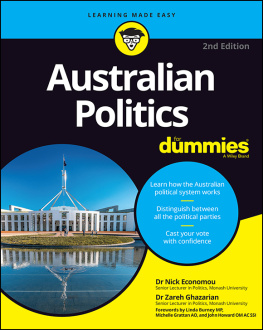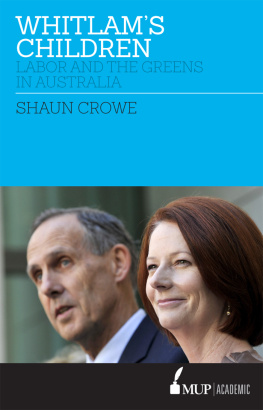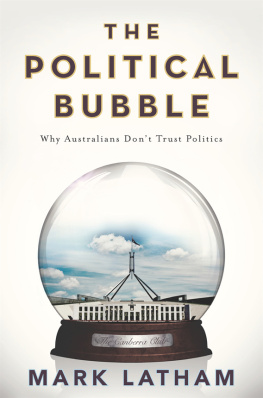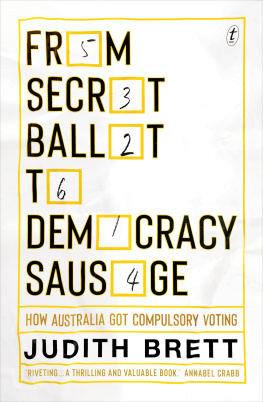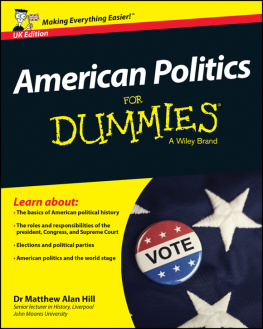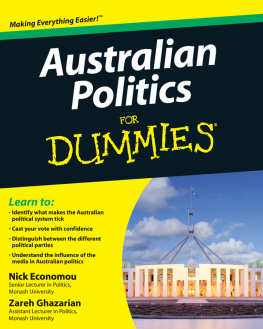

Australian Politics For Dummies, 2nd Edition
Published by
John Wiley & Sons Australia, Ltd
42 McDougall Street
Milton, Qld 4064
www.dummies.com
Copyright 2022 John Wiley & Sons Australia, Ltd
The moral rights of the author have been asserted.
ISBN: 978-0-730-39542-3

All rights reserved. No part of this book, including interior design, cover design and icons, may be reproduced or transmitted in any form, by any means (electronic, photocopying, recording or otherwise) without the prior written permission of the Publisher. Requests to the Publisher for permission should be addressed to the Contracts & Licensing section of John Wiley & Sons Australia, Ltd, 42 McDougall Street, Milton, Qld 4064, or email .
Cover image: Alex Cimbal/Shutterstock
LIMIT OF LIABILITY/DISCLAIMER OF WARRANTY: THE PUBLISHER AND THE AUTHOR MAKE NO REPRESENTATIONS OR WARRANTIES WITH RESPECT TO THE ACCURACY OR COMPLETENESS OF THE CONTENTS OF THIS WORK AND SPECIFICALLY DISCLAIM ALL WARRANTIES, INCLUDING WITHOUT LIMITATION, WARRANTIES OF FITNESS FOR A PARTICULAR PURPOSE. NO WARRANTY MAY BE CREATED OR EXTENDED BY SALES OR PROMOTIONAL MATERIALS. THE ADVICE AND STRATEGIES CONTAINED HEREIN MAY NOT BE SUITABLE FOR EVERY SITUATION. THIS WORK IS SOLD WITH THE UNDERSTANDING THAT THE PUBLISHER IS NOT ENGAGED IN RENDERING LEGAL, ACCOUNTING, OR OTHER PROFESSIONAL SERVICES. IF PROFESSIONAL ASSISTANCE IS REQUIRED, THE SERVICES OF A COMPETENT PROFESSIONAL PERSON SHOULD BE SOUGHT. NEITHER THE PUBLISHER NOR THE AUTHOR SHALL BE LIABLE FOR DAMAGES ARISING HEREFROM. THE FACT THAT AN ORGANISATION OR WEBSITE IS REFERRED TO IN THIS WORK AS A CITATION AND/OR A POTENTIAL SOURCE OF FURTHER INFORMATION DOES NOT MEAN THAT THE AUTHOR OR THE PUBLISHER ENDORSES THE INFORMATION THE ORGANISATION OR WEBSITE MAY PROVIDE OR RECOMMENDATIONS IT MAY MAKE. FURTHER, READERS SHOULD BE AWARE THAT INTERNET WEBSITES LISTED IN THIS WORK MAY HAVE CHANGED OR DISAPPEARED BETWEEN WHEN THIS WORK WAS WRITTEN AND WHEN IT IS READ.
Trademarks: Wiley, the Wiley logo, For Dummies, the Dummies Man logo, A Reference for the Rest of Us!, The Dummies Way, Making Everything Easier, dummies.com and related trade dress are trademarks or registered trademarks of John Wiley & Sons, Inc. and/or its affiliates in the United States and other countries, and may not be used without written permission. All other trademarks are the property of their respective owners. John Wiley & Sons Australia, Ltd is not associated with any product or vendor mentioned in this book.
Foreword
Although the Australian nation may have only come into existence as a federation in 1901, it is one of the oldest continuous democracies, of which I was given the great privilege of being its prime minister between 1996 and 2007. The prime minister is but the first among equals in those countries such as ours that embrace the Westminster system. However, the Australian version of the Westminster system has some special home-grown features. Indeed, Australia has been a pioneer in many democratic practices, such as the secret ballot and granting women the vote in parts of Australia well in advance of other nations. Our system of government took the best traditions, institutions and practices of Britain, with some elements from the United States, and combined them in a distinctly Australian way to make it the greatest country in the world. There are, however, some unique features of our political system that require explanation.
I was first elected to parliament in the double-dissolution election of 1974, in which all seats of parliament were contested (as opposed to a regular election in which only half the Senate seats are up for election). This election was also held less than 18 months after the 1972 election, in which Prime Minister Gough Whitlam had won a majority in the House of Representatives but not in the Senate. Seeking an early election, with the Senate having blocked six government bills, the prime minister advised the governor-general Sir Paul Hasluck the representative of Queen Elizabeth II to dissolve both houses. This made every seat in parliament vacant. After being sworn in, my first experience on the floor of parliament was the only ever joint sitting of all members of parliament from both houses. The following year, I witnessed the most significant constitutional crisis in Australian history. The Coalition blocking supply in the Senate was followed by Gough Whitlams refusal to call an election, resulting in the governor-general Sir John Kerr dismissing the prime minister in order resolve the impasse.
This book helps to explain our political system. Authors Dr Nick Economou and Dr Zareh Ghazarian provide a direct and straightforward explanation of how politics works in Australia. They are both leading researchers and commentators in Australian politics. It sometimes troubles me that many of the achievements of democratic government in our country are not as fully understood as they could be. The remarkable stability and social cohesion we sometimes take for granted in Australia owes a great deal to the effective functioning of our democracy.
John Howard, OM AC SSI
Prime minister of Australia, 19962007
Foreword
The COVID-19 pandemic reminded us of the influential role government plays in our lives. It also demonstrated the important function of citizens in shaping the government and its decisions. This requires us to be informed: to understand not just the issues, but the rules and the players.
Over the period of 120 years since federation, weve had 30 prime ministers and 46 elections. Yet, for all the rough and tumble of our politics, weve still managed to sustain a working democracy.
Like most governments around the globe, the legitimacy of the Australian political system hinges in large part on its citizens placing their faith, confidence and trust in the system and the institutions, while applying an unrelenting vigilance and scrutiny of those holding the levers of power.
Political systems must demonstrate to the citizenry, on the whole, that it works for them. The how and who have evolved over time with changing community values and attitudes. For example, when women in Australia were granted the right to vote in 1902, First Nations were excluded. It wasnt until 1962 that First Nations people were given the option to vote in federal elections, and not until 1984 that First Nations people were compulsorily enrolled. In Australia, we have sought to strike a fine and often blurred balance between guarding the fundamentals of the system and providing for constant tinkering to adapt to modern times.
In light of this, the successful 1967 referendum to amend the Australian constitution enabled the Commonwealth to make beneficial laws with respect to First Australians, as well as to count us in the census. More broadly, however, and as a political exercise, it provided an historic case study of Australias political system adjusting to meet the new and changing values and attitudes of its citizenry.
But as the 67 referendum also demonstrated, it is a two-way street: the system allows for change, but the citizenry must act upon it. The system did not simply adjust itself in 1967. The referendum was the result of a decades long community campaign from grassroots activists to precipitate structural change.
Next page
